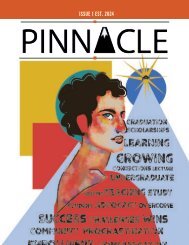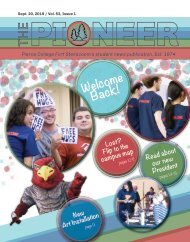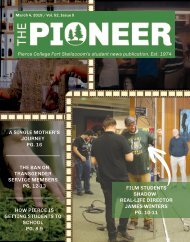The Pioneer, Vol. 53 Issue 2
Pierce College's student magazine.
Pierce College's student magazine.
You also want an ePaper? Increase the reach of your titles
YUMPU automatically turns print PDFs into web optimized ePapers that Google loves.
Hawes explained how VR headsets
could reduce in-class risk of injury or
harm in places such as science labs,
which typically require hands-on
approaches. Rather than dealing with
dangerous materials physically, it’s
possible the risk can be removed by
doing so digitally.
While STEM would be using the
headsets in ways that allow them to
simulate learning scenarios, classes
such as design could use them for
creating. Instructors such as Leigh
Rooney, assistant professor for digital
design, have been attempting to
garner interest from students.
“I’m thinking of how you can create
virtual reality environments,” said
Rooney. “There’s also some virtual
reality applications or software that
you can paint in 3D in VR, which
I think is a really cool way to think
about design.”
Earlier in October, Rooney sent
emails to her students, creating a
virtual sign up sheet for the trial run.
Rooney believes that the usage of
VR headsets can be an exciting and
brand new learning tool that Pierce
does for future classrooms.
Instructors on campus are seeing
the benefit of using headsets for in
class learning. But as ELAD continues
to work out more of the details
on the matter, certain concerns have
been mentioned by students, one of
them being the cost.
VR headsets within the gaming
community may be seen as a gimmick;
a fad that has slowly begun
losing its steam over the years. And
with the cost of headsets ranging
between $100 - $400 on average,
Pierce could be spending thousands
to supply a single classroom of 30 at
the risk of it being wasted.
Once a class is supplied, maintaining
student’s interest in using the
headsets would be the biggest challenge.
VR has been around for years
and arguably peaked between the
years of 2012 to 2016. Nathan Jefferey,
a business student at Pierce,
wonders himself how exactly Pierce
plans to get students to engage with
such devices.
“I don’t think it’ll be like a necessity,”
he said. “A lot of students, especially
older ones, I don’t think are
really going to care for VR headsets.
“Some people already feel like
they’re kind of goofy to wear. Even
gamers are kind of like, ‘I don’t want
to put that thing on’, so I can only
imagine someone who’s 30, 40, or 50
years old being asked to wear a VR
set.”
“PEOPLE WOULD
PROBABLY
INITIALLY NOT BE
AS COMFORTABLE
BECAUSE PEOPLE HAVE
THIS STIGMA THAT
THAT’S NOT HANDS ON
EXPERIENCE. YOU’RE
NOT USING THINGS
IN THE MATERIAL
WORLD, YOU’RE NOT
PLAYING WITH A
MODEL. INSTEAD
YOU’RE PLAYING WITH
A DIGITAL MODEL.
SO PEOPLE MIGHT
FEEL THAT YOU HAVE
THE SKILLS TO IT
THEORETICALLY, BUT
NOT PRACTICALLY,”
— JUSTIN HAWES, A
STUDENT AT PIERCE WHO’S
CURRENTLY PURSUING
PSYCHIATRY.
Cost and interest aside, other
concerns such as hygiene have also
been mentioned. “I’m worried about
hygienics in general,” said Hawes.
“I think that if people are constantly
swapping them, how are they going
to be handled in that regard?”
Hawes also mentions that others
on campus might also be skeptical
of the changes that could come from
switching to VR. “People are very
apprehensive to change,” he said. “I
think that because it’s a little different
I might be a little wary of getting
into it.
“People would probably initially
not be as comfortable because people
have this stigma that that’s not
hands on experience. You’re not
using things in the material world,
you’re not playing with a model.
Instead you’re playing with a digital
model. So people might feel that
you have the skills to it theoretically,
but not practically.”
Despite his fears however,
Hawes feels that a problem such
as student’s adjustment could
easily be mended with the right
methods. If ELAD could find a way
to have both digital and physical
teaching methods conjoin and
compliment one another, the
usage of VR headsets could be
invaluable.
Other concerns such as hygiene,
also prove to be less of an issue
than feared if handled properly.
Most classes at Pierce range
around 50 minutes, with many
STEM and Design coming close to
two hours. On average, students
might spend half an hour using the
headsets, allowing time for them to
be cleaned and properly handled
like any other lab equipment.
While these concerns exist,
the interest it creates is the main
reason that the headsets are going
through a trial run on campus. The
idea is still young, but discussing
both the potential costs and benefits
is exactly what ELAD wants.
Pierson spoke on the importance
of gathering awareness for the
project, as more students interested
means for better testing results.
Students interested in signing up
or learning more about it can do so
with eLearning located in CAS 322,
as they're still accepting
participants.
November. 2019 / Vol. 53, Issue 2 piercepioneernews.com / 13
Features

















